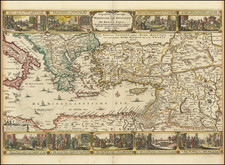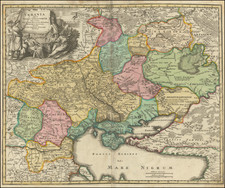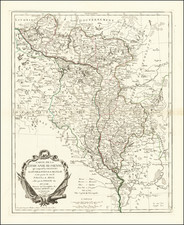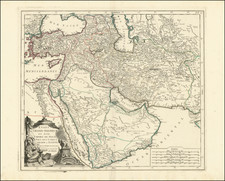Striking large format map of the European portion of the Ottoman Empire, published by famed London mapmaker William Faden.
The map provides a detailed cartographic representation of the Ottoman Empire's territories in Europe as they stood at the close of the 18th century. This historical artifact captures a significant moment just before the decline of Ottoman authority in the region, offering a window into the geopolitical landscape of southeastern Europe at a time when the balance of power was on the cusp of dramatic change.
The map delineates the vast stretch of territories under Ottoman rule, from the Adriatic Sea in the west to the Black Sea in the east, and from the Danube River in the north to the Aegean Sea in the south. It meticulously outlines the complex boundary lines, provinces, and key cities, providing insight into the administrative structure and the geographical challenges faced by the Ottoman rulers. The territories depicted encompass modern-day Greece, Bulgaria, Romania, Turkey's European section, and parts of Hungary, Serbia, and Bosnia and Herzegovina, reflecting the empire's extensive reach at that time.
Historically, the map is set against the backdrop of a period marked by internal strife and external pressures on the Ottoman Empire. The waning years of the 18th century saw the Ottomans grappling with the challenges of administrative inefficiencies, military defeats, and the burgeoning forces of nationalism within its dominions. The map thus serves not only as a geographical record but also as a testament to the empire's last years of significant influence in Europe before the onset of its gradual retreat in the 19th century.
Moreover, this map is invaluable for scholars and enthusiasts of European and Middle Eastern history, offering a tangible connection to the complex dynamics of Ottoman governance and cultural exchange in Europe. Its detailed depiction of trade routes, mountain ranges, and river systems also provides insights into the economic and environmental factors that influenced historical events in the region.
William Faden (1749-1836) was the most prominent London mapmaker and publisher of the late-eighteenth and early-nineteenth centuries. His father, William Mackfaden, was a printer who dropped the first part of his last name due to the Jacobite rising of 1745.
Apprenticed to an engraver in the Clothworkers' Company, he was made free of the Company in August of 1771. He entered into a partnership with the family of Thomas Jeffreys, a prolific and well-respected mapmaker who had recently died in 1771. This partnership lasted until 1776.
Also in 1776, Faden joined the Society of Civil Engineers, which later changed its name to the Smeatonian Society of Civil Engineers. The Smeatonians operated as an elite, yet practical, dining club and his membership led Faden to several engineering publications, including canal plans and plans of other new engineering projects.
Faden's star rose during the American Revolution, when he produced popular maps and atlases focused on the American colonies and the battles that raged within them. In 1783, just as the war ended, Faden inherited his father's estate, allowing him to fully control his business and expand it; in the same year he gained the title "Geographer in Ordinary to his Majesty."
Faden also commanded a large stock of British county maps, which made him attractive as a partner to the Ordnance Survey; he published the first Ordnance map in 1801, a map of Kent. The Admiralty also admired his work and acquired some of his plates which were re-issued as official naval charts.
Faden was renowned for his ingenuity as well as his business acumen. In 1796 he was awarded a gold medal by the Society of Arts. With his brother-in-law, the astronomer and painter John Russell, he created the first extant lunar globe.
After retiring in 1823 the lucrative business passed to James Wyld, a former apprentice. He died in Shepperton in 1826, leaving a large estate.









![(Second World War - Operation Barbarossa) A M. Kir. VIII. Honv. LGV. O. Hazamenetelének útja mecsebjelovkától kassáig [The Hungarian 8th Anti-Aircraft Battalion's Homeward Route from Mechebylove to Kosice]](https://storage.googleapis.com/raremaps/img/small/90242.jpg)




